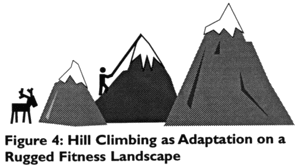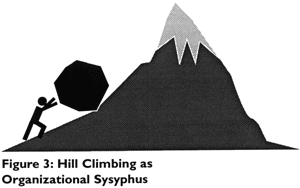
|
||
| Planners
as Nonlinear and Complex Explorers
|
||
|
Fitness Landscapes:
Exploring the Possibility Space of Adaptations Planning within the new context of the new nonlinear and complex world will make headway to the degree that planners will be able to actually explore the geographies of which they first needed to make new maps. Because this new world is so distinct from the old, without the new maps the explorers will surely get lost. Yet, the constructs according to which the new maps are being drawn are so diverse in nature and lean so often toward the arcane terminology and conceptualizations of sophisticated mathematics and highly specialized sciences, learning how to explore this new terrain by using these maps as guides is not something that can be learned over night. Nevertheless, there is an accessible key underlying these maps of complexity: it is the concept of adaptation as it has been developed in evolutionary biology. Adaptation is the ongoing process by which a species becomes "fit" to a changing environment by way of modifications in structure, form, and functioning occurring among the individual members of the species. These modifications result from both random mutations and recombination of genetic materials (e.g., found in sexual reproduction). Then, through the mechanism of natural selection, those modifications that prove helpful to a species' survival are maintained. Complexity sciences, though, add another crucial ingredient to the process of adaptation: there is an order arising out of the nonlinear dynamics itself of the system of genetic components (what Kauffman, 1995, calls "order for free") upon which natural selection operates. Hence, we can say that adaptation has four components: the utilization of random events; some kind of combinatorial process; emergent order; and natural selection. In terms of a business or institution, adaptation would also consist of random events in the sense of taking advantage of serendipity (more on that later), as well as new combinations such as connecting previously disconnected parts of the organization, ongoing experiments with new organizational processes and structures, i.e., multiple, simultaneous activities that may appear to be going in cross directions. With adaptation as a framework, therefore, planning as exploration becomes a matter of helping businesses and institutions explore the "possibility space" of the adaptive value of various modifications of structure, form, and process. The complexity influenced organizational theorist Steve Maquire (1997) refers to this exploration of the possibility space of adaptation as a design problem, in that the diverse options in business strategy are designed according to their potential adaptive value. A particular strategy and its modifications enable a business or institution to be more or less "fit" in relation to its environment. As the environment changes, the strategies will need to change to sustain the business fitness. A helpful way to expedite this more inclusive notion of planning is to utilize the tool of fitness landscapes which graphically depict the adaptive value of particular modifications. But, before we explore this vital concept in greater depth, let's contrast it with a very different type of "landscape" that is unfortunately far too prevalent in our businesses and institutions: the Sisyphean landscape originating from the Greek myth of Sisyphus who was eternally condemned to every day push a huge boulder up a steep hill, only to have the boulder fall back to the bottom of the hill at the end of the day. In the organizational counterpart to the myth of Sisyphus, the task of management is seen to be a matter of pushing work uphill everyday against an landscape of resistant employees, recalcitrant boards, and organizational inertia. This Sisyphian landscape depicts the work of management as primarily a fight against what are thought to be the given, natural tendencies of the workplace.
But this picture of bull-headed hill-climbing is not what is connoted
in complexity science's hill-climbing on fitness landscapes. Here, adaptation is indeed
hill- climbing but instead of proceeding against natural forces, it follows along the
contours of the fitness landscape which are manifesting these natural forces - contours
shaped by nonlinear dynamics, randomness, and recombination occurring as a potent amalgam
of self-organizing processes. It's not that there is no effort involved in this
exploratory hill-climbing, but it is a different, non-futile kind of effort, more like a
dance with the natural forces than a struggle against them (after all, sexual activities
leading to genetic recombination require some amount of effort, but - need I go on?). |
|
|
Getting back to fitness landscapes per se, the fitness or adaptive value of various possible modifications in the characteristics of a species are portrayed as a "landscape" with different hills, peaks, plains, and valleys (Kauffman, 1995), see Figure 4. |
|
 The height of a peak represents the fitness value of specific modifications, with nearby or neighboring peaks representing closely related modifications. For example, consider the fitness value of five fingered hands for primate survival. Such a characteristic may be represented by a fairly high peak, with neighboring peaks that are slightly shorter representing four or six fingered hands, or hands with two opposable thumbs and so forth. The point is that fairly close modifications are close by geographically with higher or lower peaks depending on their fitness value. In a business or institution, nearby peaks may represent closely related marketing or promotional strategies. Adaptation can be thought of as "climbing hills" on the landscape toward "peaks" of higher fitness, and natural selection can be conceived as how adapting populations are "pulled" up the peaks (Kauffman, 1995). A fitness landscape provides an indication of the degree to which various modifications add to or detract from the system's survivability or sustainability. Kauffman has pointed out that an important implication arising from the study of fitness landscapes is that there may be many "local" peaks or "okay" (i.e., "good enough") solutions instead of one, perfect, optimal solution. This is related to the point made by Kauffman that since an evolving species does not have a God's eye view of its fitness landscape (cannot see the contours of the landscape within which it is embedded), evolution proceeds by the population sending out "feelers" or random mutations that sample the fitness value of the hills and valleys. In other words, there are experiments in modification of an organism closer or farther way from the local peak. This is the accepted, gradualist Darwinian assumption, similar to a gradual method for problem-solving by a piecemeal, trial and error searching for solutions in a problem "space" (Kauffman, 1995). In this blind view of a fitness landscape, there are no "clues" that can guide the species toward modifications that will be more helpful for survival. So, adaptation becomes a matter of a random search. But this is only true for a totally random or maximally rugged landscape. In these totally random landscapes, for every step taken uphill, the number of directions leading to a higher landscape is cut by a constant fraction, so that it gets harder and harder to to keep improving. As a result, the rate of improvement slows exponentially. Such considerations shift the role of planners as explorers in a major way: instead of having to find the optimal strategy, one can adopt a more trial and error kind of process, seeking "good enough" local peaks, resting there, and then continuing to search either on nearby or far away peaks depending on organizational conditions.
|
||
|
Next | Planners as Nonlinear and Complex Explorers Contents | Applications Contents
Copyright © 2001, Plexus Institute. Permission |
